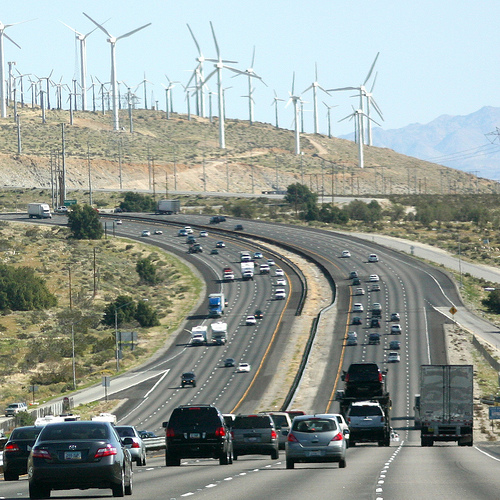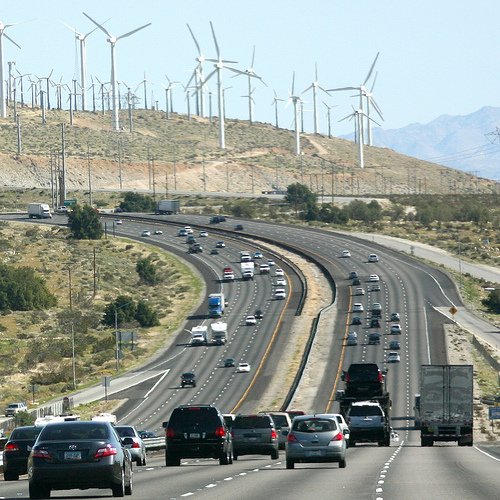 Might large-scale investment in clean energy have the same levelling effect as taxes on fossil fuels?Photo: Kevin DooleyThe demise of cap-and-trade legislation in Congress has left many feeling despondent. Given the weight of the money and political capital invested in cap-and-trade proposals, the expectant eyes of the international community waiting on U.S. climate action, the hopes of unemployed Americans riding on promises of green jobs, and the public’s expectations that political leaders would heed their calls for action — the stakes for passing cap-and-trade legislation could not have been any higher, nor could the defeat have been any more bitter. Through even the rosiest-colored lenses, Congress’ failure to act on cap-and-trade legislation last July can only be seen as a major setback.
Might large-scale investment in clean energy have the same levelling effect as taxes on fossil fuels?Photo: Kevin DooleyThe demise of cap-and-trade legislation in Congress has left many feeling despondent. Given the weight of the money and political capital invested in cap-and-trade proposals, the expectant eyes of the international community waiting on U.S. climate action, the hopes of unemployed Americans riding on promises of green jobs, and the public’s expectations that political leaders would heed their calls for action — the stakes for passing cap-and-trade legislation could not have been any higher, nor could the defeat have been any more bitter. Through even the rosiest-colored lenses, Congress’ failure to act on cap-and-trade legislation last July can only be seen as a major setback.
Not surprisingly, given the enormity of the failure, there is no shortage of blame going around. The Obama administration blames the environmental community for failing to bring Republicans to the table. The environmental community faults Obama for not getting as firmly behind cap-and-trade as he did his signature healthcare reform bill. The science community blames conservative economists for discounting the future risks of climate change and proffering go-slow recommendations for emissions reductions. Other economists criticize economic skeptics who allege that a carbon cap will ruin the economy. Conservatives chide liberals for proposing climate solutions that depend too heavily on the public sector. The left condemns neoliberals for supporting market-friendly reforms. Progressives chastise cap-and-trade proposals for doing too little to protect vulnerable households from higher energy prices. The renewables sector cites too much policy emphasis on a carbon price at the expense of R&D investment. Environmentalists blame climate science denialists for providing coverage to the fossil fuel industry. The fossil fuel industry cites rising energy demand as the reason why the world can’t afford to wean itself off of coal and oil.
All the while, Rome is literally burning …
I am not inclined to defend the cap-and-trade proposals that made their way through Congress in 2010. Suffice it to say, at this point in history and in this political climate, there is no such thing as a perfect bill; any climate bill would have disappointed for good reasons. Whether or not cap-and-trade deserves a second chance is also beyond the point. Almost all hope of Congress passing a national carbon cap (or tax) is all but dead for the foreseeable future. But whereas several years ago a defeat of this magnitude may have signified the demise of the climate protection movement, the progression of time and accumulated evidence of global warming finds us still committed to forging solutions — albeit, different ones.
From the ruin of cap-and-trade a new model is emerging: technology-first. This is the gist of a new proposal by the conservative American Enterprise Institute and Brookings to increase federal spending on clean energy innovation to $25 billion a year. It is also favored by some scientists — who were skeptical of the economistic approach to climate change reflected in cap-and-trade — as well as by technology optimists, and now it seems, some traditional supporters of cap-and-trade, including Al Gore and John Podesta.
The essence of the technology-first approach is: build it and they shall come. Rather than force a decline in fossil fuel consumption through higher carbon prices and rigid caps, this approach favors more carrot, and less stick. The goal is straightforward: transform the U.S. (and global) energy system away from fossil fuels through massive investment in renewables and energy efficiency. With sufficient investment, we can move renewable technologies along the cost-curve to the point where they can actually compete with (heavily-subsidized) fossil fuels. Once renewable energies and energy efficiency improvements become more affordable relative to fossil energies, households and businesses will reduce their carbon footprints. In the process, the U.S. develops home-grown energy sources that lessen our dependence on fossil fuel imports, creates new clean energy sector jobs, reaps the savings of improved energy efficiency, and recaptures its technological competitiveness in the global economy. Who can argue with a proposal like that?
No one, except for the fossil fuel industry, climate change skeptics who still do not see the need for new energy technologies, and fiscal conservatives who claim we simply cannot afford them. But amongst independent experts who accept climate science and who still support a vibrant public sector, I have yet to read a single opinion opposed to large-scale government expenditure on clean energy and energy efficiency. It is one of the truly win-win solutions.
But is it a solution to climate change?
Proponents of carbon pricing, whether a carbon cap or carbon tax, were never opposed to investment in renewables and energy efficiency. The R&D component was always the intended complement to a carbon price. If a carbon price is what provides incentives to buy goods and services that are less carbon-intensive, the development of clean energy technologies is what provides the options for carbon savings.
In a perfect world, U.S. solutions to climate change would be coordinated within a larger global response. In a perfect world, a U.S. climate bill would cap carbon emissions at the levels recommended by science, auction emissions rights, and allocate the resulting carbon revenues in the public interest. Ideally, this would include rebates to lower-income households to offset the impacts of higher energy costs and public investment in energy efficiency and renewables. But the revenue pool generated by allowance sales cannot fully fund both, especially if the pool is diminished by giveaways to special interests as part of the bargaining to bring the legislation to the table. Even if a cap-and-trade bill had made its way out of the Senate this summer, we would still have needed additional expenditures on R&D to facilitate the transition from fossil fuels.
A carbon price and clean energy investment are not either-or proposals. We shouldn’t feel forced to choose sides between supporting clean energy and imposing a carbon price when both are absolutely necessary. But the collapse of cap-and-trade now means that clean energy is the only game in town. In the world of second best solutions, do we lose anything by pursuing technology-first?
The efficacy of a technology-driven solution to climate change has been long debated. Some naysayers question whether the technologies represent good investment opportunities. If the technologies can be profitable, why haven’t they been implemented? When was the last time anyone saw a fifty-dollar bill lying on the sidewalk?
To respond to these critics, clean energy supporters have detailed the numerous structural and behavioral barriers that impede adoption of money-saving innovations. There are innovations proven to be cost-effective that we have failed to implement. These barriers are not insurmountable, but they will have to be addressed if a technology driven approach is to succeed.
The most significant hurdles to wide-scale adoption of clean technologies, however, stem from the cost-differentials between clean and fossil energies and the high start-up costs of large-scale energy efficiency improvements. To overcome these hurdles and drive costs down, investment will have to be much larger than it is at present. Given the scale of the investment in public goods needed, we cannot rely on the private sector alone to get the job done.
Recent proposals to push technology in the absence of a carbo
n price understand this; the aim is to make clean energy affordable. The logic is similar to that of a carbon price: we need to change the relative cost of fossil fuels. The carbon price achieves this directly by raising the costs of fossil fuels. Clean energy subsidies and investments achieve this indirectly, by lowering the cost of fossil fuel alternatives. Is either approach superior?
Existing public subsidies to fossil fuels distort the effectiveness of both a carbon price and clean energy subsidy and investment. According to a recent study, federal subsidies for fossil fuels between 2002-2008 topped $72 billion, $43 billion more than renewables received in subsidies over the same period. Removing taxpayer-supported subsidies to the fossil fuel industry could help level the playing field for clean technologies and reduce the amount of public investment needed to render these technologies cost-competitive. Having the government subsidize fossil fuels and clean energy simultaneously is an awful lot like treading water. Federal subsidies to fossil fuels, however, are not likely to go away anytime soon, and a carbon price could counter the effects of the subsidies. Couple the carbon price with large-scale public investment and we have a winning formula for making clean technologies affordable.
Most importantly, a carbon price is the public’s best option for forcing the fossil fuel industry to pay for at least some of the transition costs to a clean energy economy. What we lose by abandoning a carbon price is the opportunity to have polluters pay. Those who celebrate the demise of cap-and-trade yet support solutions to climate change sometimes overlook this fact. With a carbon price, the public at least shares some of cost of developing the clean economy with the fossil fuel industry itself.
Important questions still remain about how to best use public policy to drive innovation at such a massive scale. Do we need a Manhattan Project for clean energy or “a thousand points of light”? A disadvantage of the technology-driven approach is that it leaves the timing and total amount of emissions reduction dependent on the pace of technological change. Despite their faults, the cap-and-trade proposals before Congress this year would have capped U.S. emissions and achieved emissions reduction with certainty.
For these reasons, I remain skeptical that technology alone can and should solve the climate problem. And I am not quite ready to abandon a carbon price and let the fossil fuel industry off of the hook. But rather than despair the demise of cap-and-trade, I’ll have to hope to be proven wrong instead.



